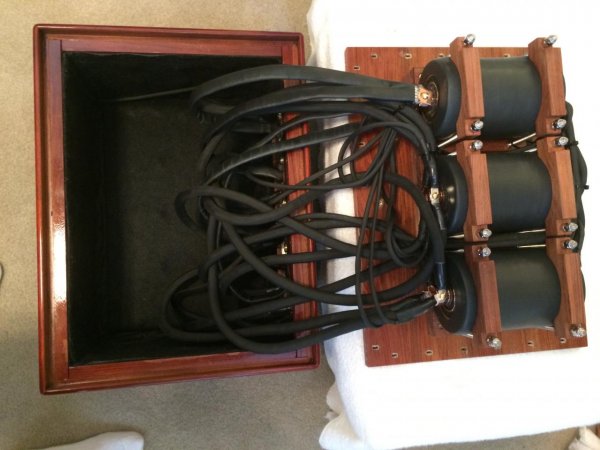The only way you will get a 75 ohm impedance cable is to use BNC .. RCA.. due to construction will never be 75 ohm impedance
whether it will matter or not is another discussion
You are absolutely correct
The only way you will get a 75 ohm impedance cable is to use BNC .. RCA.. due to construction will never be 75 ohm impedance
whether it will matter or not is another discussion
'Professional reviewers ' that is an oxymoron surely?Keith I have six ground boxes to which are attached around 20 ground cables which all work together to improve the sound of my system so what you propose as something simple is simply not the case..
Along with experienced and capable professional and lay reviewers I am happy to rely on what I hear over a period of time as opposed to invariably time limited blind testing which has been shown to have its own weaknesses.
Technical measuring techniques do not feature in the cable reviews I have read. Its the ears that determine the judgement.
Now if others wish to rely upon measurement techniques and blind testing then that is their choice.In my experience however peoples final choices and decisions are determined by what they hear just as yours was earlier with the Cesaro Chopin despite its very poor measurements.
Now I look forward to reading you response to the points put to you by JK.
'Professional reviewers ' that is an oxymoron surely?
I wouldn't trust any reviewer further than I could throw him, and that would go for a large percentage of dealers.
Keith.
Most dealers stock what they can sell, which is good business practise , I believe Majek wrote that Mola-Mola review?Really? This guy was so proud of his review that he didn't even mention his name:
http://www.monoandstereo.com/2015/08/mola-mola-makua-and-kaluga-review.html
You mean you're not a pillar of the tight knit dealer community?
Most dealers stock what they can sell, which is good business practise , I believe Majek wrote that Mola-Mola review?
Keith.
Possibly but I suspect that Majek just prefers a valve/vinyl type sound and the Molas just aren't to his taste.Not sure. Someone who had a grudge against Hypex for sure. There's always a reason if you see a review like that.

You won't be able to get far looking for timing changes with LP as the source.
The Vertex stuff seems never to have been updated. The results they show look to me like a classic case of timing differences. Small ones. As in you null two files, and a delay between them alters very slightly the nulling. When you see the classic 6db per octave tilt to residuals it will almost always be a phase difference due to timing between the two files being nulled.
An example many generic wires may only have a speed of propagation around 70% the speed of light. Other construction can allow more like 85-90% the speed of light. Nulling comparisons of two such cables even over a meter or two can show the kind of residuals Vertex was showing. Yet that slight delay in time is the only real difference. Meaningless in actual use.
It would be more interesting to look for changes in timing errors with the application of grounding and/or power conditioning: http://www.stereophile.com/rmaf2010/nordost_and_vertex_measurements/index.html#5fBjb1FJdtDCYpgG.97
amirm, you are a software guy. Thoughts on that application?
People have also pissed on the concept of power conditioning for years and we are only now beginning to recognize potential fruits: http://www.audiostream.com/content/shunyata-research-helps-save-lives#6lEm3lfokbmOd2uk.97
I personally have a soft spot for the more woo woo elements of audio. You don't know how it works (partly because of a lag in appropriate measurement tools and comprehension) but your ears tell you something may be going go. Another example is the Schumann resonance gizmos: http://www.stereotimes.com/acc011409.shtml
Like Mike L, I have heard the Tripoint grounding device twice (once in a show setting and more recently in my own listening room) and the results are not subtle. Something is indeed going on. I have seen the naked modules that Miguel uses, and they are mammoth, heavy, and beautifully fabricated. The fabrication process takes over three weeks, which is longer than a lot of the circuit board jockeys take to solder their boards together (and charge similar or even more $$$):
View attachment 25726
I have demoed most of the Vertex stuff at home. I owned their hirez power bar, but that's only coz I got a good deal. Sold it off. Now use a PP 2000 regen. The guy who bought my distribution block likes it. I tried to A/B the two multiple times but could never make out any major difference, so I gave up. Kept the regen as I have fluctuating voltage from the wall, between 237 - 253v
I didn't like their cables.
As for the isolation platforms, I found them doing something wrong to bass and details
Did the gear you were using at the time of audition have SOTA ground noise isolation circuitry?
How would said SOTA isolation circuitry be engineered? My in house demoed involved grounding a single component with a dedicated grounding post (Lampizator GG dac). Lucas is an engineer with a background in PSs, etc and used some form of star grounding.
We discussed and analyzed this back in 2010 when it came out: http://www.whatsbestforum.com/showthread.php?2199-Objective-measurements-for-power-cables. There is nothing really there.It would be more interesting to look for changes in timing errors with the application of grounding and/or power conditioning: http://www.stereophile.com/rmaf2010/nordost_and_vertex_measurements/index.html#5fBjb1FJdtDCYpgG.97
amirm, you are a software guy. Thoughts on that application?
I'm interested to learn examples of "SOTA" grounding.
I'm interested to learn examples of "SOTA" grounding.
| Steve Williams Site Founder | Site Owner | Administrator | Ron Resnick Site Owner | Administrator | Julian (The Fixer) Website Build | Marketing Managersing |






